Society in works of James Joyce
VerifiedAdded on 2023/01/18
|5
|1386
|36
AI Summary
This essay explores the portrayal of society in the works of James Joyce, focusing on themes of paralysis and corruption. It discusses the novels 'A Portrait of the Artist as a Young Man' and 'Dubliners', and highlights the impact of religion on the characters and society. The essay also examines the symbolism used by Joyce to depict the societal issues prevalent in Ireland during the 20th century.
Contribute Materials
Your contribution can guide someone’s learning journey. Share your
documents today.
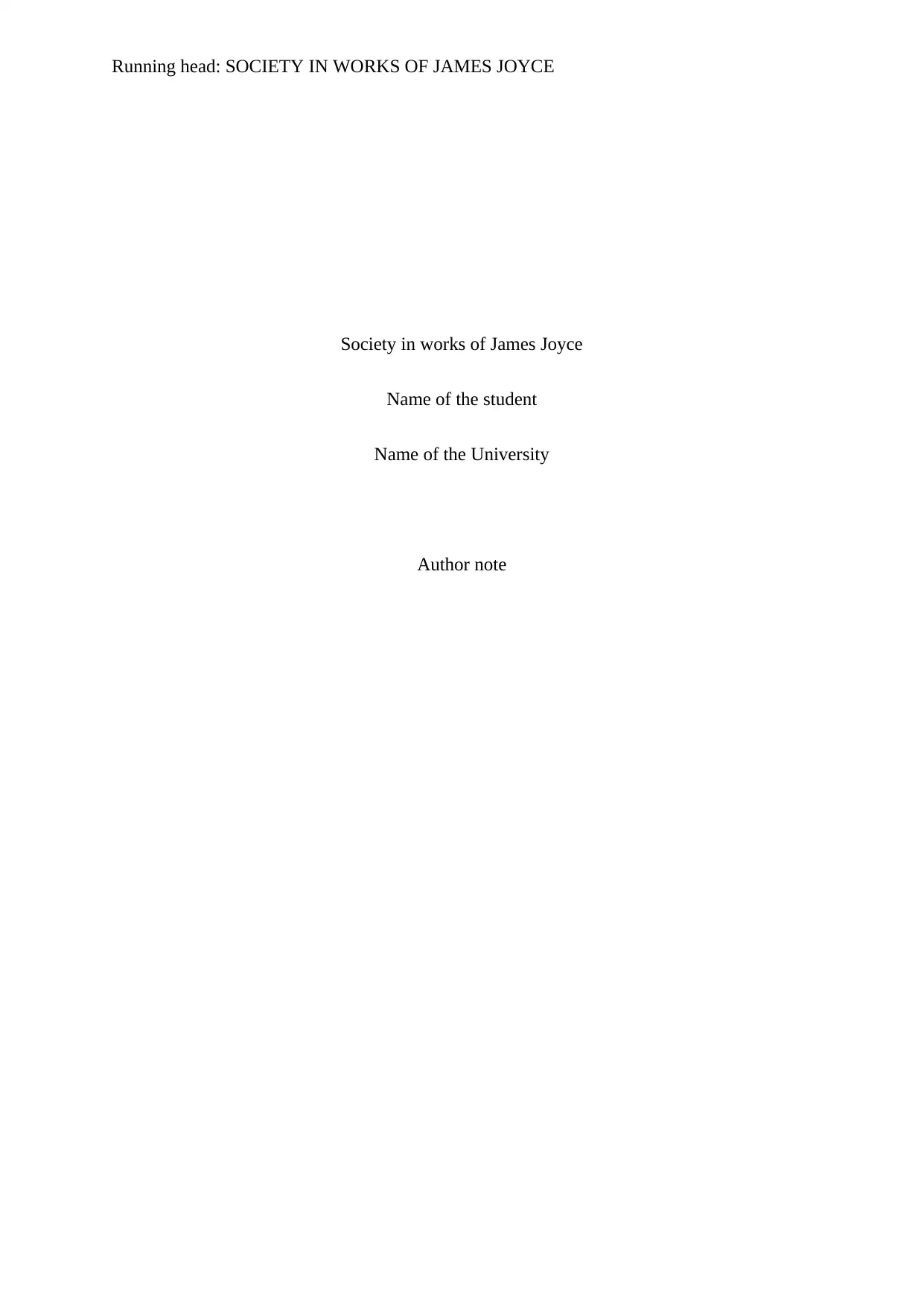
Running head: SOCIETY IN WORKS OF JAMES JOYCE
Society in works of James Joyce
Name of the student
Name of the University
Author note
Society in works of James Joyce
Name of the student
Name of the University
Author note
Secure Best Marks with AI Grader
Need help grading? Try our AI Grader for instant feedback on your assignments.
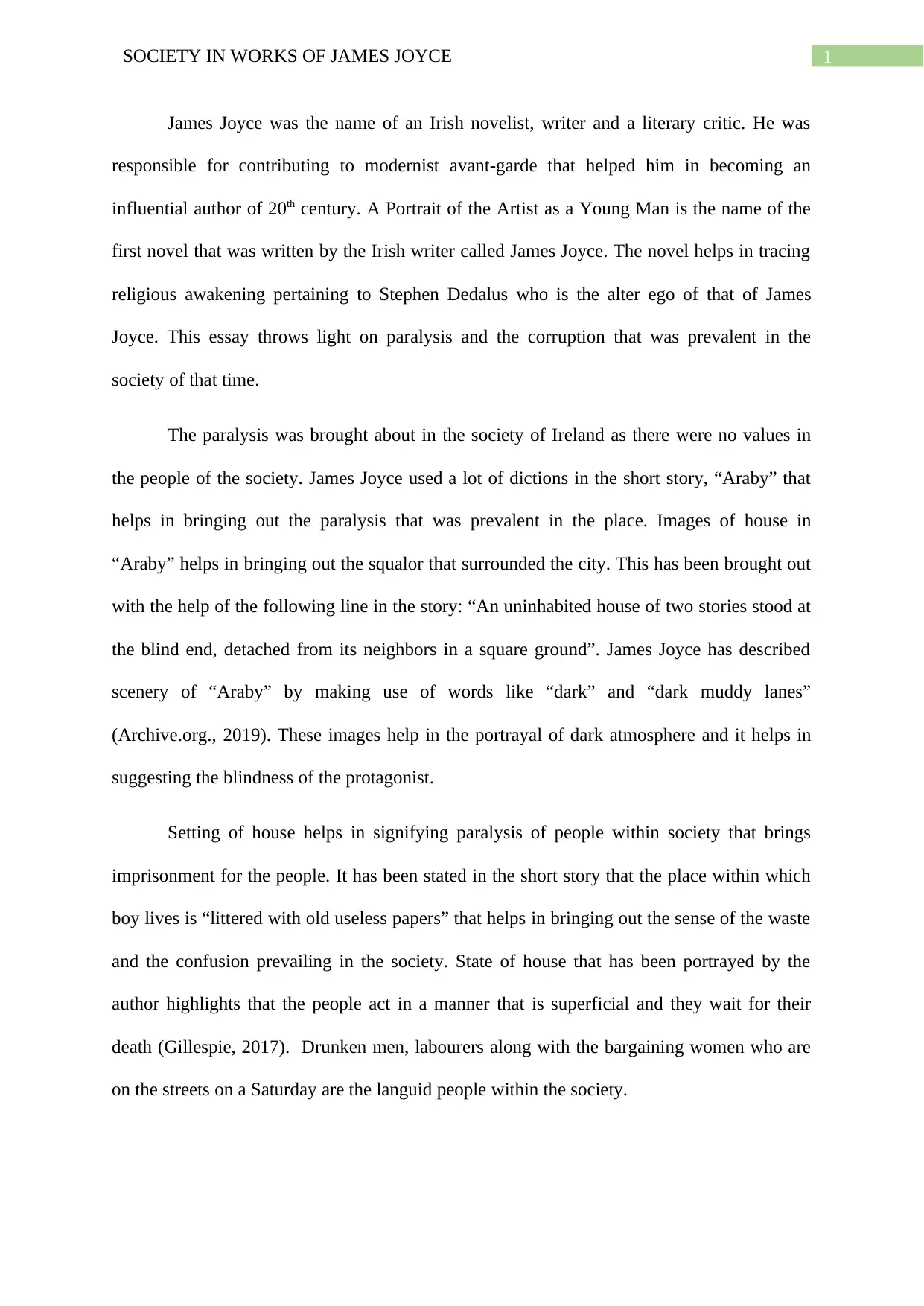
1SOCIETY IN WORKS OF JAMES JOYCE
James Joyce was the name of an Irish novelist, writer and a literary critic. He was
responsible for contributing to modernist avant-garde that helped him in becoming an
influential author of 20th century. A Portrait of the Artist as a Young Man is the name of the
first novel that was written by the Irish writer called James Joyce. The novel helps in tracing
religious awakening pertaining to Stephen Dedalus who is the alter ego of that of James
Joyce. This essay throws light on paralysis and the corruption that was prevalent in the
society of that time.
The paralysis was brought about in the society of Ireland as there were no values in
the people of the society. James Joyce used a lot of dictions in the short story, “Araby” that
helps in bringing out the paralysis that was prevalent in the place. Images of house in
“Araby” helps in bringing out the squalor that surrounded the city. This has been brought out
with the help of the following line in the story: “An uninhabited house of two stories stood at
the blind end, detached from its neighbors in a square ground”. James Joyce has described
scenery of “Araby” by making use of words like “dark” and “dark muddy lanes”
(Archive.org., 2019). These images help in the portrayal of dark atmosphere and it helps in
suggesting the blindness of the protagonist.
Setting of house helps in signifying paralysis of people within society that brings
imprisonment for the people. It has been stated in the short story that the place within which
boy lives is “littered with old useless papers” that helps in bringing out the sense of the waste
and the confusion prevailing in the society. State of house that has been portrayed by the
author highlights that the people act in a manner that is superficial and they wait for their
death (Gillespie, 2017). Drunken men, labourers along with the bargaining women who are
on the streets on a Saturday are the languid people within the society.
James Joyce was the name of an Irish novelist, writer and a literary critic. He was
responsible for contributing to modernist avant-garde that helped him in becoming an
influential author of 20th century. A Portrait of the Artist as a Young Man is the name of the
first novel that was written by the Irish writer called James Joyce. The novel helps in tracing
religious awakening pertaining to Stephen Dedalus who is the alter ego of that of James
Joyce. This essay throws light on paralysis and the corruption that was prevalent in the
society of that time.
The paralysis was brought about in the society of Ireland as there were no values in
the people of the society. James Joyce used a lot of dictions in the short story, “Araby” that
helps in bringing out the paralysis that was prevalent in the place. Images of house in
“Araby” helps in bringing out the squalor that surrounded the city. This has been brought out
with the help of the following line in the story: “An uninhabited house of two stories stood at
the blind end, detached from its neighbors in a square ground”. James Joyce has described
scenery of “Araby” by making use of words like “dark” and “dark muddy lanes”
(Archive.org., 2019). These images help in the portrayal of dark atmosphere and it helps in
suggesting the blindness of the protagonist.
Setting of house helps in signifying paralysis of people within society that brings
imprisonment for the people. It has been stated in the short story that the place within which
boy lives is “littered with old useless papers” that helps in bringing out the sense of the waste
and the confusion prevailing in the society. State of house that has been portrayed by the
author highlights that the people act in a manner that is superficial and they wait for their
death (Gillespie, 2017). Drunken men, labourers along with the bargaining women who are
on the streets on a Saturday are the languid people within the society.
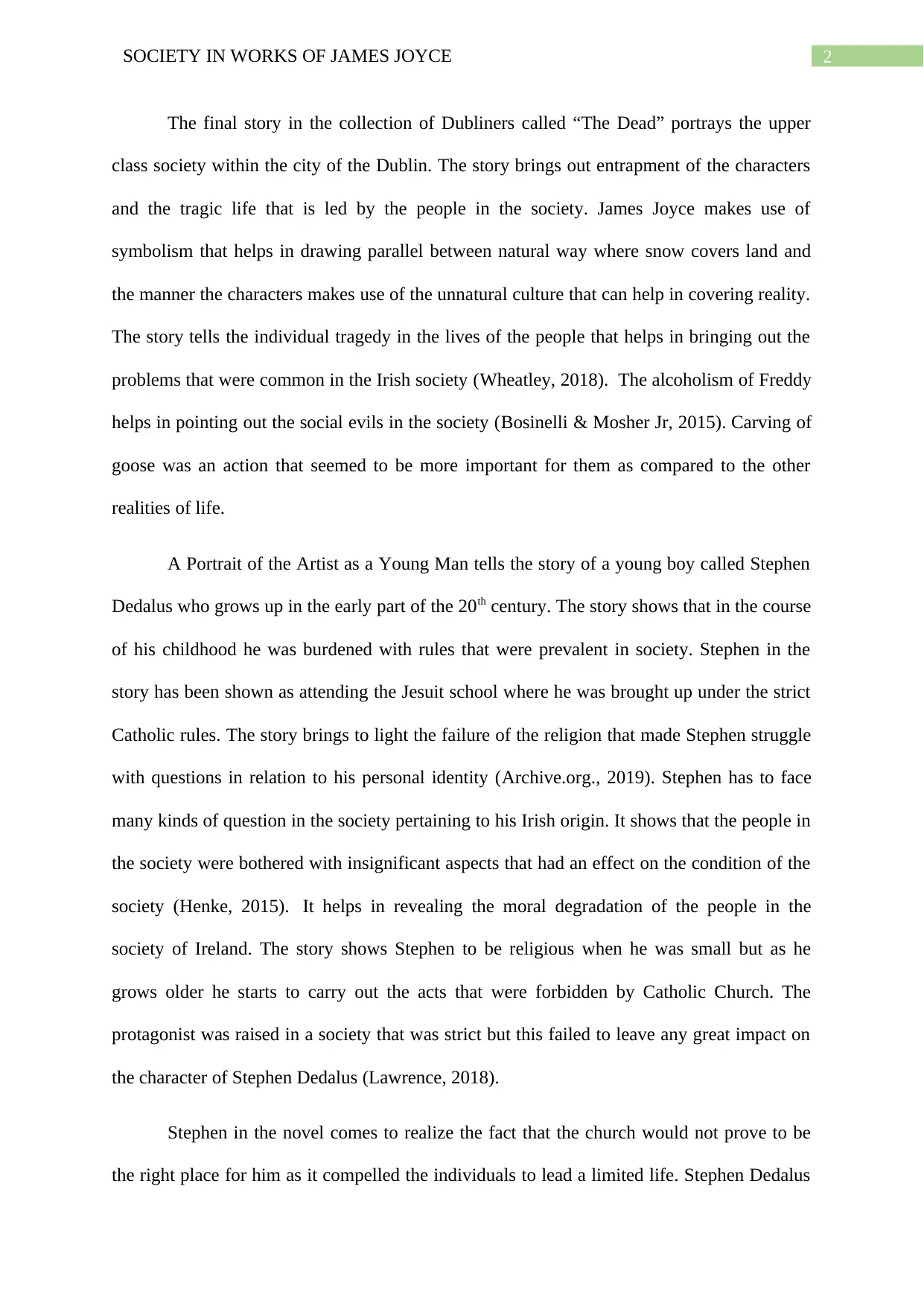
2SOCIETY IN WORKS OF JAMES JOYCE
The final story in the collection of Dubliners called “The Dead” portrays the upper
class society within the city of the Dublin. The story brings out entrapment of the characters
and the tragic life that is led by the people in the society. James Joyce makes use of
symbolism that helps in drawing parallel between natural way where snow covers land and
the manner the characters makes use of the unnatural culture that can help in covering reality.
The story tells the individual tragedy in the lives of the people that helps in bringing out the
problems that were common in the Irish society (Wheatley, 2018). The alcoholism of Freddy
helps in pointing out the social evils in the society (Bosinelli & Mosher Jr, 2015). Carving of
goose was an action that seemed to be more important for them as compared to the other
realities of life.
A Portrait of the Artist as a Young Man tells the story of a young boy called Stephen
Dedalus who grows up in the early part of the 20th century. The story shows that in the course
of his childhood he was burdened with rules that were prevalent in society. Stephen in the
story has been shown as attending the Jesuit school where he was brought up under the strict
Catholic rules. The story brings to light the failure of the religion that made Stephen struggle
with questions in relation to his personal identity (Archive.org., 2019). Stephen has to face
many kinds of question in the society pertaining to his Irish origin. It shows that the people in
the society were bothered with insignificant aspects that had an effect on the condition of the
society (Henke, 2015). It helps in revealing the moral degradation of the people in the
society of Ireland. The story shows Stephen to be religious when he was small but as he
grows older he starts to carry out the acts that were forbidden by Catholic Church. The
protagonist was raised in a society that was strict but this failed to leave any great impact on
the character of Stephen Dedalus (Lawrence, 2018).
Stephen in the novel comes to realize the fact that the church would not prove to be
the right place for him as it compelled the individuals to lead a limited life. Stephen Dedalus
The final story in the collection of Dubliners called “The Dead” portrays the upper
class society within the city of the Dublin. The story brings out entrapment of the characters
and the tragic life that is led by the people in the society. James Joyce makes use of
symbolism that helps in drawing parallel between natural way where snow covers land and
the manner the characters makes use of the unnatural culture that can help in covering reality.
The story tells the individual tragedy in the lives of the people that helps in bringing out the
problems that were common in the Irish society (Wheatley, 2018). The alcoholism of Freddy
helps in pointing out the social evils in the society (Bosinelli & Mosher Jr, 2015). Carving of
goose was an action that seemed to be more important for them as compared to the other
realities of life.
A Portrait of the Artist as a Young Man tells the story of a young boy called Stephen
Dedalus who grows up in the early part of the 20th century. The story shows that in the course
of his childhood he was burdened with rules that were prevalent in society. Stephen in the
story has been shown as attending the Jesuit school where he was brought up under the strict
Catholic rules. The story brings to light the failure of the religion that made Stephen struggle
with questions in relation to his personal identity (Archive.org., 2019). Stephen has to face
many kinds of question in the society pertaining to his Irish origin. It shows that the people in
the society were bothered with insignificant aspects that had an effect on the condition of the
society (Henke, 2015). It helps in revealing the moral degradation of the people in the
society of Ireland. The story shows Stephen to be religious when he was small but as he
grows older he starts to carry out the acts that were forbidden by Catholic Church. The
protagonist was raised in a society that was strict but this failed to leave any great impact on
the character of Stephen Dedalus (Lawrence, 2018).
Stephen in the novel comes to realize the fact that the church would not prove to be
the right place for him as it compelled the individuals to lead a limited life. Stephen Dedalus
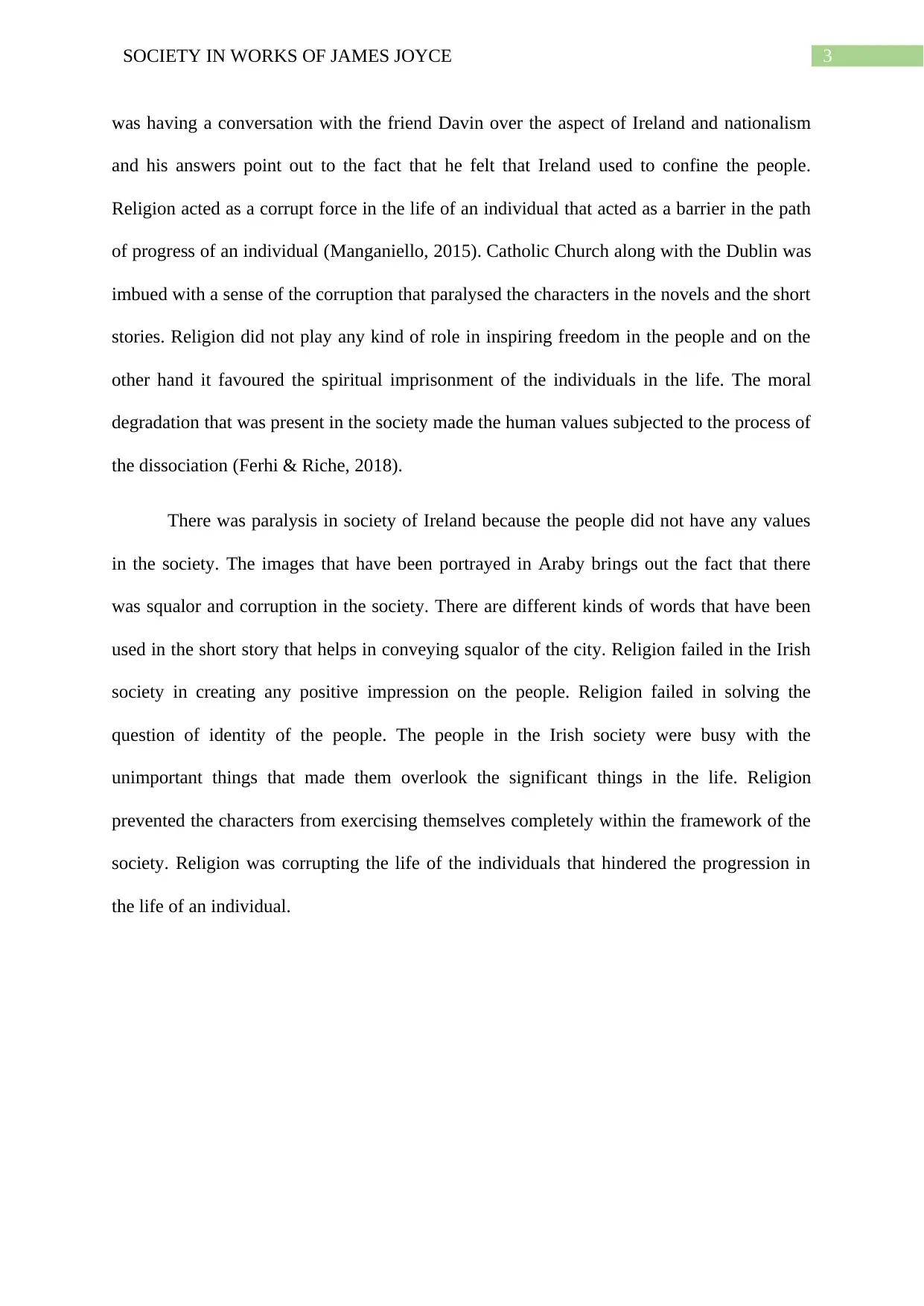
3SOCIETY IN WORKS OF JAMES JOYCE
was having a conversation with the friend Davin over the aspect of Ireland and nationalism
and his answers point out to the fact that he felt that Ireland used to confine the people.
Religion acted as a corrupt force in the life of an individual that acted as a barrier in the path
of progress of an individual (Manganiello, 2015). Catholic Church along with the Dublin was
imbued with a sense of the corruption that paralysed the characters in the novels and the short
stories. Religion did not play any kind of role in inspiring freedom in the people and on the
other hand it favoured the spiritual imprisonment of the individuals in the life. The moral
degradation that was present in the society made the human values subjected to the process of
the dissociation (Ferhi & Riche, 2018).
There was paralysis in society of Ireland because the people did not have any values
in the society. The images that have been portrayed in Araby brings out the fact that there
was squalor and corruption in the society. There are different kinds of words that have been
used in the short story that helps in conveying squalor of the city. Religion failed in the Irish
society in creating any positive impression on the people. Religion failed in solving the
question of identity of the people. The people in the Irish society were busy with the
unimportant things that made them overlook the significant things in the life. Religion
prevented the characters from exercising themselves completely within the framework of the
society. Religion was corrupting the life of the individuals that hindered the progression in
the life of an individual.
was having a conversation with the friend Davin over the aspect of Ireland and nationalism
and his answers point out to the fact that he felt that Ireland used to confine the people.
Religion acted as a corrupt force in the life of an individual that acted as a barrier in the path
of progress of an individual (Manganiello, 2015). Catholic Church along with the Dublin was
imbued with a sense of the corruption that paralysed the characters in the novels and the short
stories. Religion did not play any kind of role in inspiring freedom in the people and on the
other hand it favoured the spiritual imprisonment of the individuals in the life. The moral
degradation that was present in the society made the human values subjected to the process of
the dissociation (Ferhi & Riche, 2018).
There was paralysis in society of Ireland because the people did not have any values
in the society. The images that have been portrayed in Araby brings out the fact that there
was squalor and corruption in the society. There are different kinds of words that have been
used in the short story that helps in conveying squalor of the city. Religion failed in the Irish
society in creating any positive impression on the people. Religion failed in solving the
question of identity of the people. The people in the Irish society were busy with the
unimportant things that made them overlook the significant things in the life. Religion
prevented the characters from exercising themselves completely within the framework of the
society. Religion was corrupting the life of the individuals that hindered the progression in
the life of an individual.
Paraphrase This Document
Need a fresh take? Get an instant paraphrase of this document with our AI Paraphraser
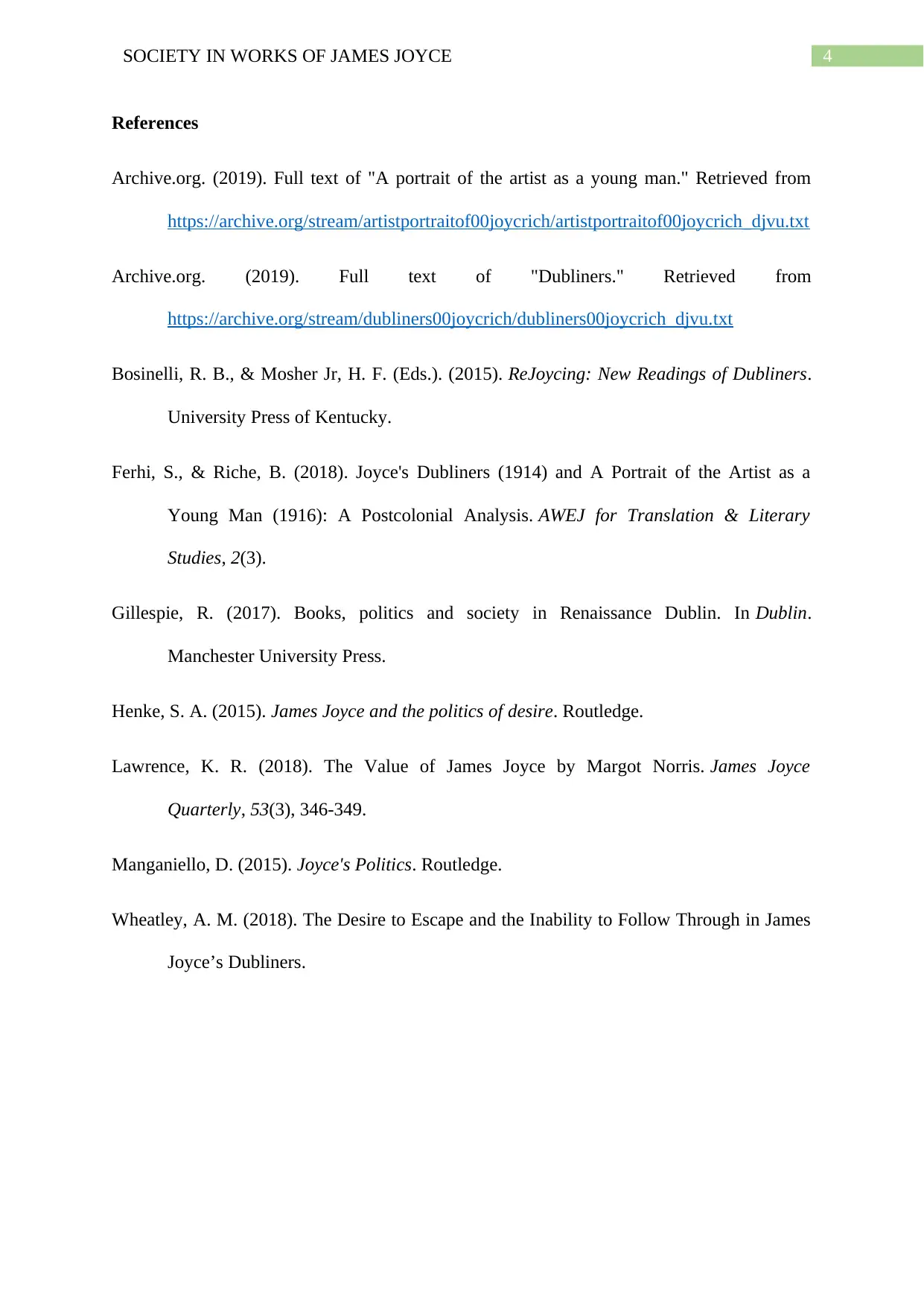
4SOCIETY IN WORKS OF JAMES JOYCE
References
Archive.org. (2019). Full text of "A portrait of the artist as a young man." Retrieved from
https://archive.org/stream/artistportraitof00joycrich/artistportraitof00joycrich_djvu.txt
Archive.org. (2019). Full text of "Dubliners." Retrieved from
https://archive.org/stream/dubliners00joycrich/dubliners00joycrich_djvu.txt
Bosinelli, R. B., & Mosher Jr, H. F. (Eds.). (2015). ReJoycing: New Readings of Dubliners.
University Press of Kentucky.
Ferhi, S., & Riche, B. (2018). Joyce's Dubliners (1914) and A Portrait of the Artist as a
Young Man (1916): A Postcolonial Analysis. AWEJ for Translation & Literary
Studies, 2(3).
Gillespie, R. (2017). Books, politics and society in Renaissance Dublin. In Dublin.
Manchester University Press.
Henke, S. A. (2015). James Joyce and the politics of desire. Routledge.
Lawrence, K. R. (2018). The Value of James Joyce by Margot Norris. James Joyce
Quarterly, 53(3), 346-349.
Manganiello, D. (2015). Joyce's Politics. Routledge.
Wheatley, A. M. (2018). The Desire to Escape and the Inability to Follow Through in James
Joyce’s Dubliners.
References
Archive.org. (2019). Full text of "A portrait of the artist as a young man." Retrieved from
https://archive.org/stream/artistportraitof00joycrich/artistportraitof00joycrich_djvu.txt
Archive.org. (2019). Full text of "Dubliners." Retrieved from
https://archive.org/stream/dubliners00joycrich/dubliners00joycrich_djvu.txt
Bosinelli, R. B., & Mosher Jr, H. F. (Eds.). (2015). ReJoycing: New Readings of Dubliners.
University Press of Kentucky.
Ferhi, S., & Riche, B. (2018). Joyce's Dubliners (1914) and A Portrait of the Artist as a
Young Man (1916): A Postcolonial Analysis. AWEJ for Translation & Literary
Studies, 2(3).
Gillespie, R. (2017). Books, politics and society in Renaissance Dublin. In Dublin.
Manchester University Press.
Henke, S. A. (2015). James Joyce and the politics of desire. Routledge.
Lawrence, K. R. (2018). The Value of James Joyce by Margot Norris. James Joyce
Quarterly, 53(3), 346-349.
Manganiello, D. (2015). Joyce's Politics. Routledge.
Wheatley, A. M. (2018). The Desire to Escape and the Inability to Follow Through in James
Joyce’s Dubliners.
1 out of 5
Related Documents
Your All-in-One AI-Powered Toolkit for Academic Success.
+13062052269
info@desklib.com
Available 24*7 on WhatsApp / Email
![[object Object]](/_next/static/media/star-bottom.7253800d.svg)
Unlock your academic potential
© 2024 | Zucol Services PVT LTD | All rights reserved.